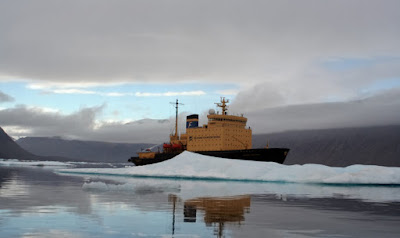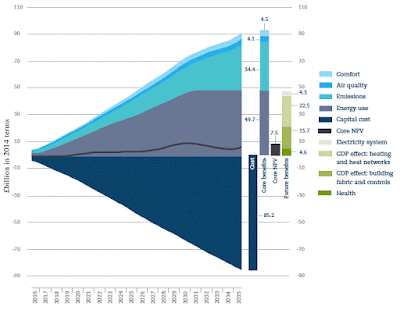 |
| Icebreaker Kapitan Khlebnikov in Arctic Waters along the NSR. Photograph by: TheBrockenInaGlory, distributed under CC-BY 3.0. |
By 2022, the volume of traffic on the Northern Sea Route (NSR) is projected by consultants Frost and Sullivan (see below) to reach 40 million tons. In 2016, the volume was already a record breaking 7.3 million tons, representing an annual 35% increase.
Russia is commissioning new facilities for the production of fossil fuel liquefied natural gas (LNG) and the development of infrastructure in the Arctic. This is planned to help significantly increase traffic through the NSR – therefore increasing global warming – and therefore improving the ability of shipping to use this route as the ice melts faster.
 |
| The dashed arrow shows the Northern Sea Route (NSR) along the Siberian Coast from Murmansk (Russia) to Cape Dezhnev in Bering Strait. |
In his speech to the Eastern Economic Forum, which was held in Vladivostok September 6–7, 2017, President Vladimir Putin talked of the "rich natural resources – coal, oil, gas and metals, as well as low energy prices, which are lower in Blagoveshchensk, Vladivostok and Khabarovsk than in Busan, Seoul, Osaka, Tokyo or Beijing" as being chief among the advantages of opening up the region and developing the Forum.
 |
| Putin with President of the Republic of Korea Moon Jae-in at the Forum. |
Putin spoke of how the Russian long term plan to make NSR attractive is being developed: "New transportation corridors are being built and ports capacities are being increased to give companies an opportunity to deliver their goods from Asia Pacific to Europe and back, as well as to other regions, as quickly and as cheaply as possible. We are scrutinising the opportunity of building a railway bridge to Sakhalin.
"Taken together with the development of the Northern Sea Route, modernisation of BAM and Trans-Siberian Railway and implementation of other projects, this will help us make the Russian Far East a major global logistics hub."
Industrial output in the Russian Far East has, at 8.6 percent, been more than double the average growth rates in the Russian Federation – the gross regional product grew by 4.2 percent indicating its value to the Russian economy.
Shrinking ice
The Northern Sea Route is the shortest sea route from Asia to Europe. According to experts, because of global warming, after 2050 it will be available for year-round passage of conventional vessels with no ice reinforcement.The sea ice is shrining fast. At the end of the northern summer this year, the ice surface is down to 4.7 million square kilometers. In the 1970s and 1980s it was roughly seven million square kilometers.
This is why Russia is driving development of the route – not only for pure export of natural resources from the Arctic zone or for the "Northern Supply", but also for container transportation.
According to Dmitry Purim, CEO of PJSC Sovfracht, "the main driver of the Arctic development, the undisputed mainstream, is the realization of hydrocarbon projects".
As the ice retreats, the Arctic routes will become shorter and faster. With the current trend, by 2030 the Arctic will completely get rid of ice in the warm season. So, cargo ships will be less likely to require the help of icebreakers, and navigation will be open at least 6 months a year.
Russian plans
The container traffic on routes where the use of the NSR can potentially give a significant payoff to carriers, is about 455 thousand TEU.The commercial operation of the NSR is in full swing now, especially in the western part (from Murmansk to the port of Sabetta). The traffic volume can already be compared to the European numbers, say Frost and Sullivan (report sent by email, not yet online).
Evgeny Ambrosov, the First Deputy General Director of PJSC Sovcomflot and Vice-President of the Arctic Economic Council, said at the Forum: "The further growth in freight turnover will be due to the commissioning of new LNG production capacities (Arctic-LNG, Pechora-LNG) and the development of oil and gas fields. By 2025, the NSR will transport about 65 million tons of hydrocarbons."
Commenting on the results of the panel, Leonid Petukhov, the General Director of the ANO "Far East Investment and Export Agency", stressed that: "The development of the NSR is moving in all major directions—the icebreaker fleet is gradually growing, the infrastructure is being upgraded, work is being done to remove administrative and trade barriers; on the whole, conditions are being formed for increasing the volumes of container transportations in the medium term, private (including foreign) investors are involved in the projects."
LNG-powered ships
The fleet of Russia's largest shipping company, Sovcomflot, has recently been supplemented by three new MR vessels (6 in total), and in August 2017, Christophe de Margerie (reinforced ice class Arc-7) gas carrier made its first commercial flight delivering LNG from Norway to the South Korea.The vessel went through the NSR for a record 6.5 days without the help of an icebreaker. "Christophe de Margerie" is the first gas carrier in a series of 15 vessels of this type planned for construction.
There are some climate benefits for the construction of new vessels using LNG as fuel. According to E. Ambrosov, it will reduce the volume of carbon dioxide emissions by 15%, nitrogen emissions by 80%, and sulfur emissions by 90%. The construction will start in 2019 at the Zvezda plant, and the first ship will leave the shipyard in 2022.
Foreign companies are demonstrating high interest in using the Northern Sea Route. "Japan has two main interests related to the NSR. The first one is the diversification of transport routes between Asia and Europe and the second is the development of the energy base," said Shinichi Ishii, senior consultant at Nomura Research Institute, Ltd. "The Hokkaido government has a program to participate in the NSR, and in the future, Hokkaido intends to become a gateway to the NSR."
Reduction in the ice area in summer and autumn makes the NSR more attractive for sea container transport. "On the average, over a decade the ice thickness is reduced by 13%" said Riccardo Valentini, professor at the Tuscia University (Italy) and head of the European Mediterranean Climate Change Center. "We need to improve the accuracy of sea forecasts, ice conditions and seasonal risks."
Note:
The thematic panel "Development of the Northern Sea Route. From words to action" was held September 6, 2017 within the framework of the 3rd Eastern Economic Forum with the assistance and support of ANO "Far East Investment and Export Agency".
The discussion gathered a number of industry professionals—representatives of Russian and international scientific organizations, as well as functional and top managers of oil and gas, shipbuilding and transport companies from Russia, Japan, South Korea, China, the Netherlands, etc. Among them was Evgeny Ambrosov, First Deputy General Director of PJSC Sovcomflot, Tero Vauraste, Chairman of the Arctic Economic Council, Vladimir Korchanov, First Vice-President of FESCO, Rene Berkvens, CEO of Damen Shipyards Group NV, Riccardo Valentini, Nobel Peace Prize Laureate and Head of European Center for the Mediterranean Climate Change, and others. Alexander Dyukov, Chairman of the Board and General Director of PJSC Gazprom Neft, also visited the session.
After the discussion, the session moderator, Managing Director of the Russian Frost & Sullivan office Alexey Volostnov and the Director General of the ANO "Far East Investment and Export Agency" Leonid Petukhov signed an agreement on coordination of activities to improve the conditions for the implementation of the socio-economic development strategy of the Far East until 2020, and on the effective assistance to the development of the Northern Sea Route.
The source for many of the quotes above is the Russian Frost & Sullivan office.





